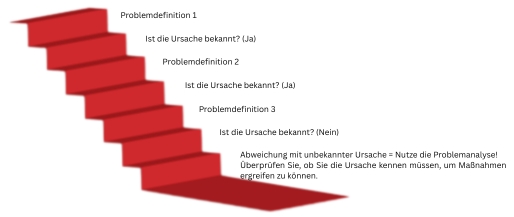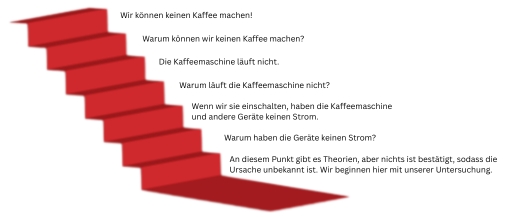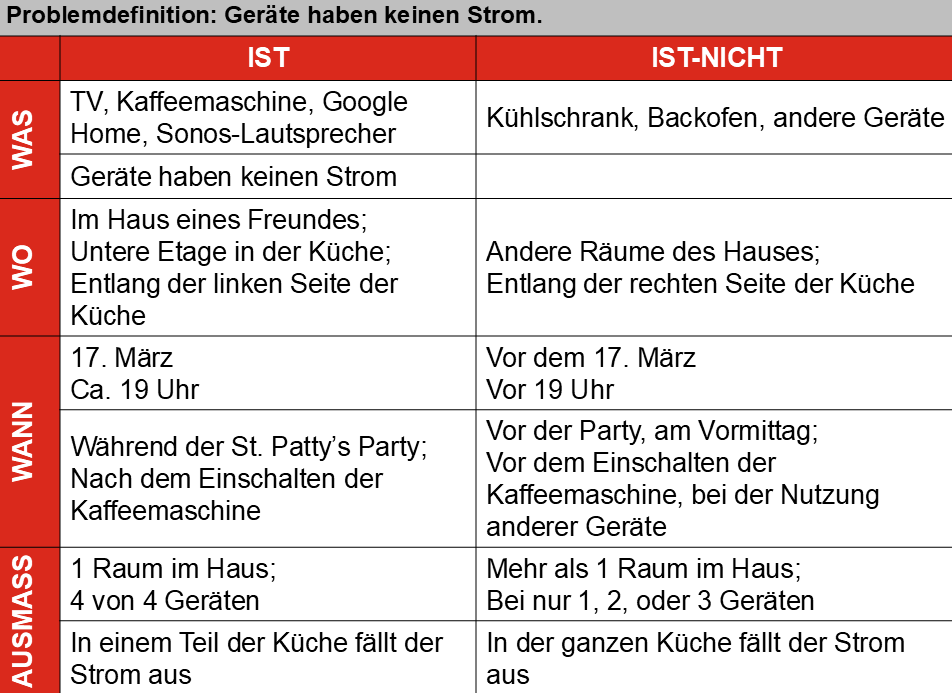Als die Kaffeemaschine ausfiel, retteten Problemlösungsfähigkeiten den Abend.
Die besten Lektionen im Troubleshooting entstehen aus alltäglichen Frustrationen. Zum Beispiel, wenn eine harmlose Bitte um einen Kaffee nach dem Abendessen plötzlich zur Meisterklasse im systematischen Problemlösen wird.
Die Krise
Samstagabend, 19 Uhr. Das Essen war vorbei, als unser Gastgeber fragte: „Möchte jemand Kaffee?“ Nach einem üppigen Mahl klang Koffein perfekt.
Ein paar Minuten vergingen – kein Kaffee. Dann die gefürchtete Ansage: „Tut mir leid, Leute – die Kaffeemaschine macht Probleme. Jedes Mal, wenn wir sie einschalten, fällt der Strom aus.“
Sofort kam der Ruf: „Die Kaffeemaschine ist kaputt!“ Doch mein Freund und einige Gäste begannen instinktiv, die Situation mit systematischer Logik zu analysieren – genau so, wie wir es in unseren Kepner-Tregoe-Trainings für Problemlösungen lehren.
Der Ansatz der KT Problemanalyse
Die Kepner-Tregoe Problemanalyse hilft, die Ursache einer Leistungsabweichung anhand von Daten – nicht Annahmen – zu finden. Der Prozess beginnt mit einer klaren Problemdefinition, bei der die Ursache noch unbekannt ist.
Dazu nutzen wir die „5-Why“-Technik, um die Ursache-Wirkungs-Kette nachzuvollziehen:

Das sind unsere Fragen:
- Die Kaffeemaschine lässt sich nicht einschalten – Warum?
- Power goes out when we try to turn it on – why?
- Der Stromkreis ist überlastet – Warum?
- Zu viele Geräte ziehen gleichzeitig Strom – Warum?
- Geräte haben keinen Strom – Warum? Da dies eine Frage ist, die wir nicht mit gesundem Menschenverstand, Wissen, Erfahrung oder Beobachtung beantworten können, ist dies unsere Problemdefinition.

Daten organisieren: Was IST betroffen?
Mit der Problemdefinition „Geräte haben keinen Strom“ stellten wir gezielte Fragen, um unsere Beobachtungen zu ordnen. Diese Daten bilden den „IST“-Teil der Problemanalyse-Matrix, die wir später sehen werden:
- Welche Geräte haben keinen Strom? → Kaffeemaschine, Fernseher, Google Home, Sonos-Lautsprecher
- Wo tritt es auf? → Nur auf der linken Seite der Küche
- Wann begann es? → Gegen 19 Uhr, als wir Kaffee machen wollten
- Wie stark ist der Ausfall? → Vier Geräte betroffen, vollständiger Stromausfall, ein Bereich betroffen
Die Macht des „IST-NICHT“
Hier liegt der Schlüssel: Die meisten konzentrieren sich nur auf das, was IST – also was nicht funktioniert. Echtes, systematisches Troubleshooting erfordert aber ebenso den Blick auf das IST NICHT, also was NICHT betroffen ist. Hier helfen uns unsere Fähigkeiten zur Problemlösung von Anfang an auf dem richtigen Weg zu bleiben, falsche Ursachen auszuschließen und bewahren uns möglicherweise davor, Geld für eine brandneue Kaffeemaschine zu verschwenden:
Kritische IST-NICHT-Fragen enthüllten:
- Welche ähnlichen Geräte haben NICHT die Stromleistung verloren? → Kühlschrank, Ofen – sie hätten betroffen sein können, waren es aber nicht
- Wo funktioniert der Strom normal? → Rechte Küchenseite und alle anderen Räume
- Wann funktionierte alles zuletzt normal? → Nach unserem Wissen bis etwa 19 Uhr
- Was hätte theoretisch auch ausfallen können, ist es aber nicht? → Es könnten nur ein, zwei oder drei Geräte betroffen sein, statt alle vier. Es könnten auch mehrere Räume betroffen sein, statt nur die Küche.

Der Durchbruch
Mein Freund stellte die Kaffeemaschine ins Wohnzimmer – und siehe da: Sie funktionierte einwandfrei. Keine Stromprobleme. Damit war klar: Der Standort machte den entscheidenden Unterschied.
Neue Fragen kamen auf:
- Was unterscheidet die Küche von den anderen Räumen?
- Warum nur die linke Küchenseite und nicht die rechte?
- Was war um 19 Uhr anders als am Vormittag, als alles funktionierte?
Die Antwort
Alle betroffenen Geräte (Kaffeemaschine, Fernseher, Google Home, Sonos) liefen über denselben Sicherungskreis. Kühlschrank und Ofen hatten eigene Sicherungen. Am Vormittag lief nur die Kaffeemaschine auf diesem Stromkreis, am Nachmittag jedoch mehrere Geräte gleichzeitig.
Das Urteil: Keine defekte Kaffeemaschine – sondern ein überlasteter Stromkreis. Die Maschine war lediglich das letzte Gerät, das den ohnehin schon strapazierten Stromkreis zum Zusammenbruch brachte.
Die Lösung
Mein Freund tauschte den defekten Schutzschalter aus. Problem gelöst. Er musste nicht herausfinden, warum der ursprüngliche Schutzschalter immer wieder auslöste – nur, dass er ausgetauscht werden musste.
Die Lektion
Dieses einfache Beispiel veranschaulicht, wie systematisches Troubleshooting funktioniert:
- Wir haben das eigentliche Problem definiert – hier haben wir die beliebte 5-Why-Analyse verwendet, um das Problem zu identifizieren, das wir lösen müssen
- Anschließend verglichen wir mithilfe der Kepner-Tregoe-Problemanalysematrix, was funktioniert und was nicht.
- Wir haben diese Deten dann verwendet, um logisch die wahrscheinlichste Ursache abzuleiten und herauszufinden, was als Nächstes zu tun ist – ob es sich um eine schnelle Lösung handelt oder eine sorgfältigere Entscheidung erfordert.
Bei komplexen Problemen können Sie mithilfe von IST- und IST-NICHT-Daten mögliche Ursachen testen, indem Sie fragen: „Wenn dies die Ursache ist, wie erklärt sie, was IST und was NICHT IST?“
Wenn Sie das nächste Mal vor einem vermeintlich „defekten“ Gerät stehen – treten Sie einen Schritt zurück. Denken Sie nach dem Prinzip „IST“ und „IST NICHT“. Ihr defektes Gerät könnte lediglich der Hinweis auf ein tieferliegendes Systemproblem sein.
Erfahren Sie mehr darüber wie 5 Whys und Fishbone-Diagramme mit der Kepner-Tregoe Problemanalyse zusammenhängen
Verbessern Sie Ihre Problemlösungsfähigkeiten mit einem Root Cause Analysis Workshop


